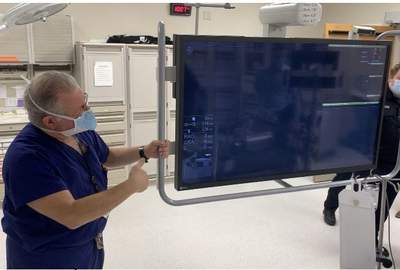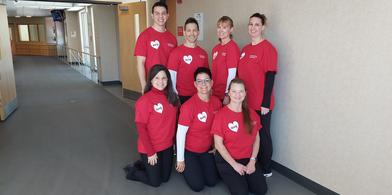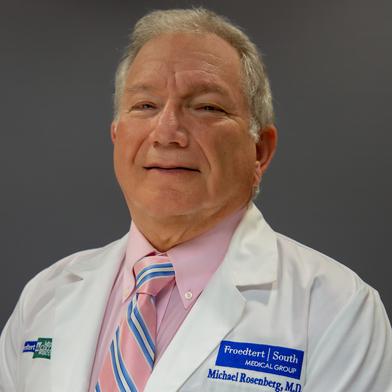When it comes to treating heart attacks, time is muscle.
The faster cardiologists can open a blocked artery that is causing a heart attack and restore blood flow, the less damage to the patient’s heart.
A new “Straight to Cath” program launched by Froedtert South Hospital’s cardiology department in partnership with emergency medical services at fire departments around Kenosha County aims to save time — and lives — by empowering paramedics to bypass the emergency room for some heart attack patients, taking them directly to the cardiac catheterization lab.
“This process saves about 40 minutes,” said Dr. Michael Rosenberg, an interventional cardiologist with Froedtert South.
That amount of time, he said, can make a huge difference in outcomes for a heart attack patient.
Rosenberg said he was part of a team that pioneered a similar program in Manitowoc. Froedtert South began working on the program several months ago, first with the Kenosha Fire Department.
James Poltrock, the retiring division chief of emergency medical services at KFD, said the program uses skills the department’s paramedics already had — the department has repeatedly been recognized by the American Heart Association for its success in treating heart attack patients — and combines them with a new protocol.
“This isn’t something out of their skill set. This isn’t something they had to have new training to do,” Rosenberg said of the paramedics. “They all had the skills.”

Cardiologist Dr. Michael Rosenberg with a screen used by surgeons in the cardiac catheterization lab at Froedtert South hospital as he explains the process when patients reach the lab with paramedics. - KENOSHA NEWS PHOTO BY DENEEN SMITH
EKG tests
For years, when KFD rescue workers were called for reports of chest pain, paramedics did an EKG test on the patient in the ambulance, sending the results of the EKG to the hospital. Paramedics like William Swanson and Andy Belsky, who took part in a drill for the program last week, were already trained to read the EKG results. They know how to recognize the type of heart rhythm that shows a heart attack.
In the past, paramedics would have called into the emergency room to let staff know the patient was on the way, transmitting the EKG to the hospital for staff at the emergency room. Once at the emergency room, Rosenberg said, the ER doctors and staff would likely run the same tests paramedics had already done on the ambulance, then alert the cath lab team that a patient would be heading their way.
Now, Rosenberg said, when a paramedic recognizes on the EKG a heart attack that requires catheterization, the paramedics themselves call the cath lab team — sending the EKG results to the cardiologists’ phones — and deliver the patient directly to the cath lab.
Swanson and Belsky explained that in the ambulance on the way to the hospital, paramedics now get the patient ready to go straight into surgery. They change the patient into a gown, shave them, and put on specialized defibrillator pads and EKG patches that can be used during catheterization.
“We’re doing all this right as we’re going down the road,” Swanson said.
Swanson said the department has a similar program in place for stroke patients.
When the patient arrives at the hospital, a team is waiting to bring them to the lab. The paramedics can watch the catheterization from the windows of an observation room as the cardiologist uses a balloon to open the blocked artery.
“It takes about 10 to 15 minutes from getting the patient on the table to opening the blockage,” Rosenberg said.

Kenosha Fire Department paramedic William Swanson, left, looks over an EKG while riding in an ambulance with cardiologist Dr. Michael Rosenberg. - DENEEN SMITH, KENOSHA NEWS
‘Drastic improvements’
“We’ve seen drastic improvements in our door to balloon time,” said Scott McArthey, director of operations at Froedtert South. “We’ve seen drastic improvements in the time from first medical contact (with paramedics) to the time they are in the lab opening up the artery.”
McArthey said patients who have come through the lab with the new program have, on average, been able to go home from the hospital the following day.
Aurora Hospital, which does not have a 24-hour catheterization lab at its Kenosha hospital, does not have a similar program with the fire departments.
Rosenberg said the “Straight to Cath” program launched with the Kenosha Fire Department on Nov. 4 then expanded to the Somers and Pleasant Prairie fire and rescue departments. By the end of the year, he said, it should be in place at all of the fire departments in Kenosha County.
Rosenberg said the key to its success is to make sure the paramedics and EMTs involved feel empowered to use their skills, and that they aren’t worried there will be repercussions if they make the wrong call.
Not all heart attack patients will go straight to the cath lab, Rosenberg said. Those patients who are having heart attacks but are too medically unstable to go straight to catheterization will still go to the emergency room, as will those people with chest pain who have EKGs that don’t show evidence of a blocked artery.
Swanson and Belsky said they have not yet taken a patient directly to the lab themselves, but they said other paramedics with the department have made the call and have been proven correct in their diagnosis.
“So far we’re 4-for-4,” Swanson said.


